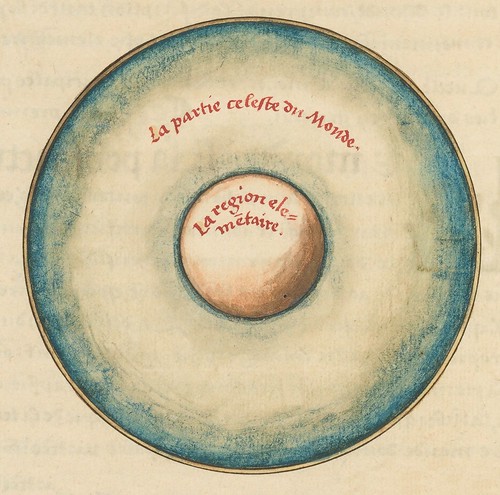
Geocentric (Ptolemaic) model of the universe


The interaction between the four classical (Hellenic) elements
and their properties : earth fire air water -- hot dry cold wet
and their properties : earth fire air water -- hot dry cold wet


Compass rose with compass points
 This is a global map projection: attempting to render spherical surface
This is a global map projection: attempting to render spherical surfacein a 2-dimensional plane (the last image below shows Fine's
most famous world map in cordiform -- heart-shaped -- projection)





Oronce Fine (or Orance Finé) (1494-1555) was a third generation physician from France. He was also a teacher and prolific author in the fields of mathematics, geography, cartography and astronomy and he held the chair in mathematics at the Collège Royal in Paris for more than twenty years.
"Fine was a quintessential polymath, equally at home in the workshop as in the study. Not only did he make and sell his own instruments, he also designedFine's prodigious output allowed for errors to appear in his published works however, and it was wildly exaggerated claims - for instance, he claimed to have squared the circle in myriad ways - that attracted contemporary criticism of his intellectual powers.
maps, prepared the illustrations for his many books, and worked as an editor and
overseer in Paris’s bustling printing houses."1
Until recently1, Fine's achievements in the history of scientific enquiry have been judged closer to footnote status than significant offerings. It has long been held that Fine was a mere populariser of scientific tenets outlined by his own teachers and predecessors and that he had made few, if any, original contributions to scientific thought. But a more sympathetic view of Fine has emerged with a re-evaluation of the leading role he played in elevating mathematics, in particular, to a position of high intellectual merit in Renaissance-era France.
Given his energetic pursuit of both theoretical and practical disciplines, Fine was uniquely placed to attract serious attention from royalty and nobility whose patronage was obviously important in advancing 17th century French scientific pursuits. Fine also published, or contributed towards the publication of, more than seventy books, in Latin, that were widely read in his own country and also throughout much of the Holy Roman Empire.
"Fine was much more representative of the mathematical culture of the period than the extraordinary figures who have tended to monopolise historians’ attention. Arguably, indeed, he did much more to shape the nature of that culture than many of those who are now more famous than him." [A Mosley]1The current manuscript, dedicated to Henri II, from which the images above were drawn, is simply one example of Oronce Fine's diverse interests. The illustrations, in addition to the text, were produced by Fine himself. It was published in book form in the early 1550s but breaks no particular new ground and simply recycles ideas proposed by Aristotle, Ptolemy and Sacrobosco*.
- 'Le Sphere du Monde, proprement dicte Cosmographie' [approx: The known universe or Cosmography] by Oronce Fine, 1549 is online at Harvard University.
- Oronce Fine biography (et en Français) [W].
- 1I am greatly indebted to Dr Alexander Marr from USC who kindly provided a copy of the introduction to a book about Fine he edited. It is a collection of articles examining Fine's published record within relevant scientific subject areas. The commentary above draws heavily from this introduction (not available online). 'The Worlds of Oronce Fine: Mathematics, Instruments and Print in Renaissance France' 2009, edited by Alexander Marr.
- via Houghton Library Blog.
- Previously : cartography | astronomy | astrology.

'Mappemonde Cordiforme d'Oronce Fine' {about 1534}
[this map is not in Fine's astronomy manuscript]
[this map is not in Fine's astronomy manuscript]
{Fine was noted for his cordiform or heart-shaped maps of the world. Another of his heart-shaped maps included the mysterious Terra Australis land mass - albeit joined to Antarctica - for the first time: LINK}
"Oronce Fine was one of the rare French geographers in the Renaissance to prepare maps of the world. This map is bordered with a handsome Renaissance decoration: two columns support a pediment bearing a Latin inscription signifying "A new and complete description of the world," interrupted in the middle by a coat of arms of France. Also to be noted is a vast southern land mass (Terra Australis), recently discovered but not yet explored." [source]



Tidak ada komentar:
Posting Komentar